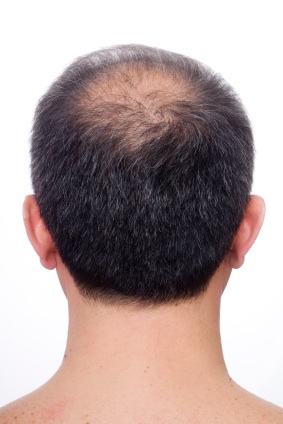Thinning Hair and Hair Loss
Hair loss in any form is a cause of distress for most people. Many assume that thinning hair, or loss of hair is simply an unavoidable aspect of aging. Others assume it is determined by heredity and therefore, cannot be avoided. It is important to note that there are numerous causes of thinning hair and a variety of treatments available to address this issue. Often thought of as a problem primarily plaguing men, the issue of thinning hair and/or hair loss affects numerous people, both male and female, sometimes at a fairly young age.

Hair Loss Terms
- Alopecia is the common medical term used to describe the loss of hair either on the head, or on any part of the body.
- Male Pattern Baldness refers to the loss of hair from the front and central part of the head, with hair usually remaining on the sides and back of the head.
- Female Pattern Baldness is a term used to describe the thinning of hair on a woman’s head. Typically this is an overall thinning, not specifically affecting a woman’s hairline, with the primary spot for thinning being on the top of the head.
- Effluvium is a term that is used in combination with other medical terms to describe the type of hair loss. The word by itself means a shedding of hair.
- Trichotillomania is a condition where a person, either child or adult, is in the habit of pulling out normal, healthy hair.
How Hair Grows
There are three basic phases of hair growth in normal hair follicles. The growing phase is called anagen. This is the longest phase and can last from two to eight years. Next is a transition phase that represents the time when the hair has stopped growing and is entering the resting phase. This period lasts for about two to four weeks, as the hair follicle shrinks, and the hair stops growing, but remains attached.
This transitional phase is called catagen. The last phase is the resting phase, or telogen. This phase lasts from two to four months. After the resting phase is over, the hair naturally falls out, as new hair grows in to replace it. On any given day, it is estimated that a person with a normal, healthy head of hair has up to 100 hairs that have finished the telogen phase and fall out.
Symptoms of Hair Loss
The symptoms for hair loss are quite obvious in most instances, particularly for men. A visibly receding hairline is often the first indicator. For women, it may take some time for the thinning to be noticeable. In fact for some women, the first indicator is a noticeable increase in the quantity of hair coming out in a brush, or collecting in a drain after the hair has been washed. In some instances, a woman may be alerted to the condition by her hair dresser. In any case, whether male or female, the loss will eventually be visible to the eye.
Causes of Hair Loss
Hair loss can be caused by a vast number of things(opens PDF). In many instances, a person’s head of hair can reflect a person’s overall health.
Thinning Hair? Get Remedies Fast!
In some instances, the loss can be caused by a known drug, the most obvious being chemotherapy. It is important to note that other drugs can also cause hair loss, including some drugs used to treat common ailments like high blood pressure or depression. This type of hair loss is sometimes referred to as Anagen Effluvium, as in many cases, the hair falls out or is disrupted during the anagen or growing phase. Anagen Effluvium is also found from exposure to chemicals like mercury.
Poor nutrition can be blamed for some cases of hair loss. From B5 (Pantothenic Acid) to B2 (Riboflavin), to a deficiency in essential fatty acids, people who are not adhering to a well balanced diet may experience some form of hair loss. Essential vitamins and minerals are vital to healthy hair.
Physical and emotional stressors can also cause a person to experience thinning hair. A severe illness or a sudden loss of weight, are both common causes of hair loss. Some cases of hair loss can be directly attributed to thyroid issues or anemia.
In some instances, hair loss is permanent, and may be caused by inflammation brought on by a variety of skin conditions. This type of hair loss is called Scarring Alopecia, and typically occurs when, as the name implies, hair follicles are scarred.
The most common cause of baldness or thinning hair is frequently attributed to three things: hormones, heredity and aging. Although this type of balding can begin as early as the teen years for men, it is more frequently observed with age, and seems more likely to have a strong connection to heredity.
Risk Factors
When reading through the causes listed previously, there are some obvious indications of those who are at higher risk for hair loss and thinning hair. Some factors, like heredity, are beyond a person’s control. Others, like diet and stress can be addressed and approved either alone, or with help.
Preventing Thinning Hair

First and foremost, pay attention to your overall health. Consume a well balanced diet and take a multi vitamin. If you regularly experience stress, try to incorporate a daily de-stressor into your schedule. Consider activities like yoga, meditation, or virtually any kind of physical exercise. These are all proven stress reducers, and can play big part in a person’s overall well-being, which in turn plays a part in your hair health.
For women or men with long hair, refrain from putting your hair up in braids or tight pony tails, as the stress of sustained pulling on the hair can cause hair loss. Be cautious of using harsh chemicals in any aspect of your life, but particularly in hair dyes or other hair treatments. Consider incorporating any of the herbal remedies shown to promote healthy hair. (See Treatment Options).
Testing and Diagnosing
Because there are a wide variety of conditions that can contribute to hair loss, tests performed during a diagnosis are also widely varied. From a nutritional analysis, to blood tests, to the microscopic study of a sample hair shaft, a patient may undergo any number of types of tests to rule out, or diagnosis underlying health conditions. In some rare instances, for some conditions, a skin biopsy might even be performed.
Treatment Options
Depending on the underlying cause of hair loss, and if it can definitively be diagnosed, treatment options are varied.
For patients experiencing hair loss that is attributed to aging or heredity, there are a wide number of prescription drugs currently being prescribed. Minoxidil, also known as Rogaine, is widely used. It comes as a topical solution, and is applied directly to the scalp. Finasteride, also known as Propecia, is an oral medication prescribed for men only. It works to block the negative effects of male hormones on hair loss.
For Minoxidil products, the most common side effect is an itchy scalp, often treated with a simple dandruff shampoo. For Finasteride, side effects may include erectile dysfunction, or decreased libido, but these are seen in less than 20% of users.
Surgical hair transplantation is another viable option. In this procedure, healthy hair follicles are moved from one area of the scalp to an area that is balding. The side effects associated with this type of treatment are pain, swelling and some bleeding, all diminishing with time. A patient may also experience headaches, which normally can be treated with over the counter pain relievers.
For some patients, simple natural treatments are available and recommended, especially to treat hair loss that is attributed to diet or stress. Vitamins and exercise are two obvious, but very key treatment options.
Herbal Options
There are a number of herbal remedies recommended for the treatment of thinning hair or baldness. These remedies generally fall into two categories: those taken internally and those applied topically. Topical remedies might include a mixture of essential oils like thyme, rosemary, lavender and cedarwood, applied directly to the scalp. Another commonly used topical treatment is coconut oil.
This treatment is particularly popular with women as it acts as a natural conditioner. Aloe Vera has also shown promise in promoting thick, healthy hair. Burdock Root Oil is another popular treatment, often added directly to your existing shampoo, making it a particularly easy one to try.
Herbal remedies taken internally include herbs used to improve blood circulation, including gingko biloba. Horsetail is another herb that is used to promote circulation and blood flow. It is thought to increase hair strength, and is frequently taken as tea. Other herbs, like green tea, are believed to block enzymes linked to hair loss. Green tea may be found either as a drink, or in capsule form. When trying any herbal treatment, it is important to watch for any allergic reaction, as these types of reactions are the most likely side effects.
Trichotillomania
For patients diagnosed with Trichotillomania, treatment may include Cognitive Behavioral Therapy (CBT), performed by a trained psychologist. Generally speaking, this involves an attempt to determine the exact triggers causing a patient to pull out hair, and then teaching the patient ways to respond differently to those triggers. Some patients respond best to a combination of CBT and medication, such as one of the standard medicines used to treat depression. Others have been helped with dietary changes, hypnosis, yoga, or other natural remedies.
Scarring Alopecia
The most difficult type of hair loss to treat is the Scarring Alopecia variety. Because it is difficult to treat, most physicians will attempt aggressive treatment that may include corticosteroids in topical cream form or in injection form, or any of a variety of prescription drugs. Once a patient with this form reaches a time where the hair loss seems to have ceased, if any healthy hair follicles remain, the patient may be a good candidate for transplant surgery.
As with the treatment of any physical condition, it may take some time to determine what treatment protocol works best for each individual person. What works for one person may not produce the same results in the next. Research is constantly under way, investigating new possibilities for the treatment of hair loss.
Next Steps for Treating Hair Loss
For any person dealing with thinning hair or hair loss, it is important to realize that there are number of possible causes, and a number of available treatments. Taking time to examine your overall health and diet is the best first step.
For those who feel that heredity is leading them down a path of male or female pattern baldness, taking a pre-emptive strike may be the best possible path. Of course this includes diet and stress management, but it may also represent a great opportunity for the introduction of any of the numerous natural remedies associated with promoting hair growth.

1 Comment
my son has alopecia areata and loosing eyebrows on both brows.
What would you recommend?
Thank you.